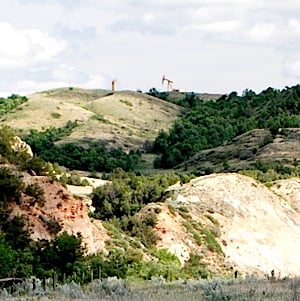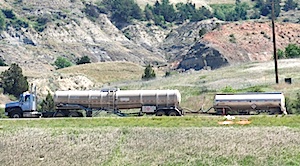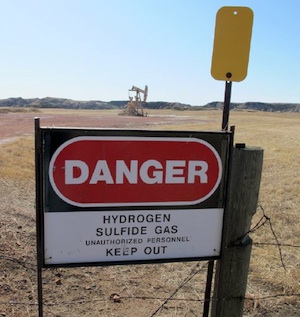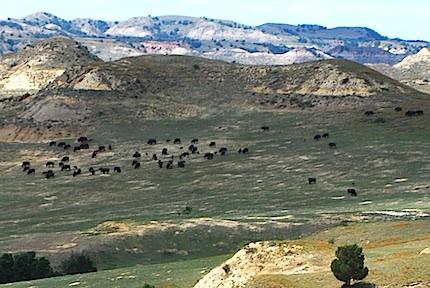On clear, calm nights, from the top of Buck Hill you can see them flickering off in the distance. Not campfires, but rather gas flares, emblematic of North Dakota's energy boom, glimmering after dark.
Here, in the South Unit of Theodore Roosevelt National Park atop the 2,855-foot hill, the flares are just one sign of how the boom, driven by "fracking," is impacting the park. Other impacts arrive in the form of industrial truck traffic on two-lane highways rimming the park and threading through the region, air quality issues, noise, higher lodging costs, and more wear and tear on campgrounds.
"Even though they’re not drilling in the park, or under the park, the things that are on the boundaries, that go by the park and impact us, are huge,” said Valerie Naylor, the park's superintendent.
Boom Times In North Dakota
The Bakken Boom, which is squeezing oil and natural gas from beneath the northwestern corner of North Dakota and slowly is expanding its reach, has been good for the state in many ways. Unemployment is in the low single-digits, and the tax revenues have been a welcome infusion to the state's coffers.
At the same time, as populations have grown with the latest form of migrant workers -- those chasing the energy boom, not here to pick fruit -- crime rates have risen. Rural communities have seen a decided change of lifestyle, and road crews are struggling to upgrade routes to handle the truck traffic.
Slowly being surrounded by some of these impacts is not just the national park, the place where Theodore Roosevelt had the "snob" taken out of him, but also more and more of North Dakota's state parks. Today these bucolic places are being hemmed in by energy development and its associated impacts.
“I don’t want to give the impression that I'm against all of this," said Mark Zimmerman, North Dakota State Parks and Recreation director. "But from state parks and my involvement with all of the outdoor recreation, we scratch our heads to think how do we stay ahead of this, how do we address this? It’s minor compared to road work and hospitals and water systems, and housing and schools, but the quality-of-life people do want to recreate and we do have to figure that out.”
At the national park, Superintendent Naylor said the energy boom has brought exploration and pumping equipment to the park's borders, and it hasn't gone unnoticed by visitors.
"The North and South Units have wells within a mile of the boundary and more to come. Some of them have more impacts than others. Of course, they have an impact on the viewshed, they have an impact on the soundscape," she explained. "We have had people backpacking in the wilderness in the South Unit and have asked what was all the drumming that they heard all night, and that is from oil wells.
"... We also have air-quality issues. Not severe air-quality issues, but we do see dust, particulates, there's the flaring," the superintendent said. "The skies are brighter than they used to be. We still have dark skies, but they’re not as dark as they were. And this is an exceptional star-gazing place."
The boom even is encroaching on the spot where Theodore Roosevelt gained his appreciation for the outdoors and his conservation bent. Today oil and gas development seemingly is bearing down on his beloved Elkhorn Ranch.

The Elkhorn Well is visible from the Elkhorn Ranch. Kurt Repanshek photo.
A proposal, first broached in the 1970s and recently revived, would have a bridge span the Little Missouri in large measure for "increased traffic demands from the oil and gas industry."
The Little Missouri Crossing proposal being considered by the Federal Highway Administration, the North Dakota Department of Transportation, and Billings County (North Dakota) does not call for the bridge and the connecting road to physically intrude on the Elkhorn Ranch site that is a part of the national park. However, one of the options under consideration would bring the bridge and its envisioned traffic close enough to intrude on the site, according to opponents.
What Will Full-Field Development Bring?
Some fear the worst is yet to come.
“Right now, in western North Dakota there’s been over 6,200 wells drilled. There’s over 200 rigs there right now. They anticipate at full build-out there’s going to be 45,000 wells," saids Tim Stevens, Northern Rockies regional director for the National Parks Conservation Association. "Now when you’re going to be overlooking this landscape that’s foundational to Theodore Roosevelt and his conservation ethic, you’re now looking at, in the distance, flares, and oil and gas facilities, and rigs. So it’s something that is permanently altering the landscape as we speak.
“There’s a whole bunch of new wells being drilled within sight distance of the park," Mr. Stevens went on. "Signs that say, 'Caution, natural gas, hazardous to your health'" within sight of the park's boundaries.
And yet, the boom does bring benefits to communities that rely on tourism, benefits in the form of oil field workers with money to spend and a desire to kick back and relax in the parks, both state and national.
"We live in a spoiled society that demands cheap gas and a nice place to stay — with no one else around," Leona Odermann, director of the Medora Visitor Center, told USA Today's Laura Bly earlier this summer. "We have a product here that people need and want. Why shouldn't we benefit economically?"
Struggling To Handle Campers
And, certainly, the oil field workers should be able to recreate, said Mr. Zimmerman. But the state parks officials need to figure out how best to manage the increased pressures those workers bring, he added.
"We’ve never had that kind of population in the western part of the state," the state parks director pointed out, adding that before the Bakken Boom "something like a Juniper Campground (in Theodore Roosevelt) or our state park at Lewis and Clark, we could easily handle that traffic. But when a Williston, and a Watford City and a Tioga and a Stanley all increase in population and families, and they want to recreate, something like that campground at Juniper is no longer adequate to serve that population.
“They come to our parks, and they’re even coming further east. We manage two parks to the east end of Lake Sakakawea, and their visitation and their camper counts are 30 percent higher than last year. And again, you can see it when you go in to the campground, it’s the oil service workers," Mr. Zimmerman said. "And I’m not knocking them, but you can drive down the campground and it’s those pickups with the (oil service companies') names on them and they’re there recreating, they’re there with their families, or they’re there fishing themselves, two or three of them fishing. But it’s that increased boom of population that taxes us for the campgrounds."

Oil tankers pass regularly by the national park's North Unit entrance. Kurt Repanshek photo.
“I don’t consider myself a wide-eyed environmentalist, but I know in our state parks, I’ve seen it and my managers caution us, 'Don’t make us use that campsite every night, because in two, three weeks it’s not a very nice looking campsite for the next night,'" the North Dakota official said. "You need to let them rest. And we’re seeing that impact as the oil boom is not allowing us do that.”
However, production apparently proved more bountiful than initially expected.
"When the agreement was made, the drilling pad was going to have maybe one or two drilling rigs or wells on it," Mr. Zimmerman said. "Now that could be up to five or six, so there most definitely will be flaring, they won’t be able to move all that gas off. That’s a concern of mine because it’s noise and the visual, you’re sitting in the campground, you could take your hot dog over there (to the flare) and cook it."
Are Buffer Zones Realistic?
While the companies have shown a willingness to work with state and federal land managers to minimize and mitigate impacts, talk of ringing parks with production-free buffers has come up. Similar talk did, too, in Utah back in 2008 when the outgoing administration of President George W. Bush extended oil and gas exploration leases close to Arches National Park and Dinosaur National Monument. But the problem then, and now, is how to physically define such a buffer.
“I think that there should be conversations about having some size of a buffer," said NPCA's Mr. Stevens, who quickly adds that he doesn't know how one would be laid out. "That would be something in terms of size that we’d really have to spend some time with the Park Service to figure out what’s reasonable. But yeah, I think it could have to do with having a buffer zone around the park, it could have something to do with being able to understand what the impacts are to park resources, based not only what’s on the ground now, but what’s anticipated in the future. What does full field development look like around Theodore Roosevelt National Park?
“And how can we begin mitigating those impacts as development is phased in?" he added, mindful of that projection that full-field development could involve 45,000 wells, or more than seven times the current level. "How can we make sure that places like the Elkhorn are protected.”

The dangers associated with oil field development approaches Theodore Roosevelt's boundaries. NPCA photo.
"And in some cases we have successfully mitigated some of the impacts of the drilling on the park, by working with the oil companies. Some of them have been very amenable to helping us in ways that they can, by orienting the pump jacks a different way, or making the 'treater,' which is a vertical device, horizontal so it doesn’t show up so much, moving tanks, things like that," she explained.
"Minimizing flaring, putting hospital-grade mufflers on the engines when they are not electric so that they’re not so loud. And so they have helped us in that way, they are not required to do so, much of the time, but they do if we ask. If we find out about the wells we can work with those companies.”
NPCA, Mr. Stevens pointed out, is not opposed to oil and gas development. But the organization does believe strategies need to be developed to protect the national park, what it represents, and the visitor experience.
"We need to make sure that we are protecting those views and vistas, and that we are protecting the night skies around Theodore Roosevelt National Park. Right now, it’s starting to become dotted with natural gas flares. How can we get it back to the point where the complete experience of Theodore Roosevelt National Park is still there that we can hand down to future generations?" he wondered. "It’s not only the viewsheds, but it’s the night skies and also how can we protect the natural sounds and the natural quiet that visitors can experience at Theodore Roosevelt."




Comments
I visited TRNP for the first time last summer, and was completely blindsided by the oil boom. It's not the campers staying in the state parks to recreate. It's the campers staying in the state parks because they literally have nowhere else to go. I stayed in the campground at Ft. Buford near Williston, and I think I was the only person there who wasn't working in the oil fields and getting up early in the morning to drive to work the next day.
There was an article in the local news the night I stayed in a motel in Belfield about how Williston is completely unable to hire enough teachers to teach the enormous influx of oil field workers' children, not because they can't afford to pay them, but because there is literally nowhere for them to live. People camp in Walmart parking lots. The state park campgrounds are luxurious in comparison.
TRNP is a gloriously beautiful place, and I hope it can be preserved in spite of everything, but it's going to be a long hard go for that to happen. This is the modern-day version of the Klondike Gold Rush.
That's for sure. It might be my favorite national park, and what's happening there makes me nervous.